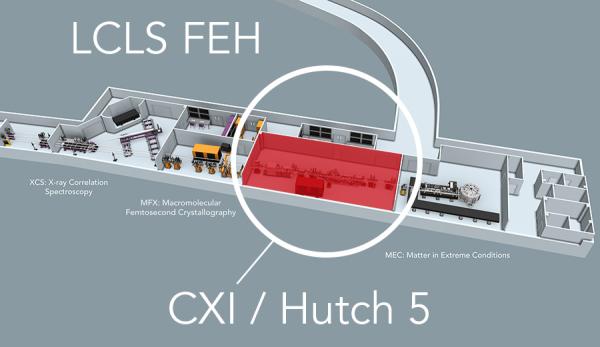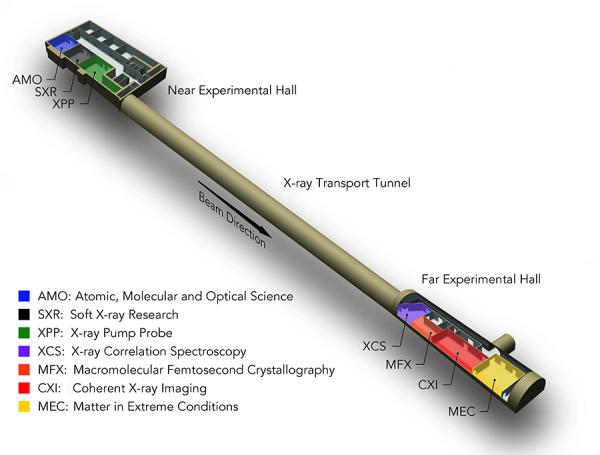CXI Specifications
Beamline Specifications
Diagnostics Stand in the X-ray Tunnel
Devices
- Pulse Picker
- Attenuators (10 filters)
- X-ray Focusing Lenses
Purpose
- Rapidly shutter the X-ray beam
- Control the incident beam intensity
- Pre-focus the X-ray beam or produce a ~10 micron focus at CXI
Diagnostics Stand 1
Devices
- Reference Laser
- Slits 1
- Profile-Intensity Monitor
- Differential Pump
Purpose
- Produce a visible reference line for alignment
- Slit the beam down and reduce unwanted halo, Define the beam entering the KB mirrors
- Measure the incidnet beam profile entering the CXI hutch
- Separate the vacuum of the KB mirrors from the upstream beamline
0.1 micron KB Mirrors
Devices
- 100 nm KB mirrors
Purpose
- Focus the X-ray beam to a ~100 nm spot
1 micron KB Mirrors
Devices
- Slits 2
- 1 micron KB mirrors
- Slits 3
Purpose
- Slit the beam down and clean the beam before entering the KB mirrors
- Focus the X-ray beam to a ~1 micron spot
- Slit the beam down and clean the beam entering the KB01 mirrors or the beam exiting the KB1 mirrors
0.1 micron Sample Chamber
Devices
- 100 nm interaction region
Purpose
- Location of the ~100 nm focus
Detector Stage (A location)
Devices
- Full size CSPAD
- X-ray Focusing Lenses
- Attenuator or beam stop
Purpose
- Forward scattering measurements with the nanofocus chamber
- Refocusing or collimating the 100 nm focus for reuse downstream
- Attenuate the beam passing through the CSPAD hole or block it entirely
Diagnostics Stand 2
Devices
- CSPAD 140K or X-ray Focusing Lenses
- Slits 4
- Intensity-Position Monitor
- Profile-Intensity Monitor
- Differential Pump
Purpose
- Measure the low angle forward scattering from the 100 interaction region
OR
- Change the divergence of the 1 micron KB beam and control the spot size in SC1
- Slit the beam down after the refociusing lenses or clean the beam before after the 1 micron KB mirrors
- Non-destructive relative measurement of the pulse intensity
- Measure the beam profile on the way to the 1 micron focus, after the 100 nm focus or after the refocusing lenses
- Isolate the 1 micron sample chamber environment from the upstream part of the beamline
Detector Stage (B location)
Devices
- Full size CSPAD
OR
- Time Tool
- Pulse Selector
- Attenuators (6 filters)
- Slits 5
- Differential Pump
Purpose
- Back scattering measurements with the 1 micron focus
OR
- Cross-correlate the arrival time of the X-rays and pump lasers
- Rapidly shutter the X-ray beam or control the repetition rate for SC1
- Control the incident beam intensity
- Slit the beam down after the refocusing lenses or clean the beam before after the 1 micron KB mirrors
- Isolate the 1 micron sample chamber environment from the upstream part of the beamline
1 micro Sample Chamber
Devices
- 1 micro Sample Chamber
Purpose
- Location of the ~1 micron focus and of the refocused 100 nm beam
Detector Stage (C location)
Devices
- Full size CSPAD (Front detector for SC1)
- Attenuator or beam stop
- Pulse Selector for refocused 1 micron beam
- X-ray focusing lenses for refocusing or collimating the 1 micron focus
Purpose
- Forward scattering measurements with the micron focus chamber (High angle detector)
- Attenuate the beam passing through the CSPAD hole or block it entirely
- Rapidly shutter the X-ray beam or control the repetition rate for SSC
- Refocusing or collimating the 1 micron focus for reuse downstream
Serial Sample Chamber
Devices
- Interaction for refocused 1 micron beam
Purpose
- Location of the refocused 1 micron beam
Detector Stage (D location)
Devices
- Full size CSPAD (Back detector for SC1)
OR
- Full size CSPAD (Detector for SSC)
- Attenuator or beam stop
Purpose
- Forward scattering measurements with the micron focus chamber (Low angle detector)
OR
- Forward scattering measurements with the refocused beam in SSC
- Attenuate the beam passing through the CSPAD hole or block it entirely
Diagnostics Stand 3
Devices
- Single Shot Spectrometer
Purpose
- Measure the single shot X-ray spectrum
Diagnostics Stand 4
Devices
- Intensity-Position Monitor
- Profile-Intensity Monitor
Purpose
- Non-destructive relative measurement of the pulse intensity
- Measure the beam profile at the end of the CXI hutch, after all focusing optics and all interactions with samples or diagnostics



